by Winding Pathways | Jun 10, 2016 | Bugs, Nature, Pests
We are proud of and fortunate that our yard is home to a wide array of fascinating plants and wildlife.
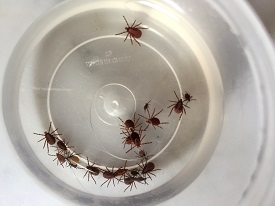
Only a good friend would know that we want pictures of creepy crawlies and save them for us for our blog!
But, last year Rich encountered a wild animal that he wishes he’d avoided. A deer tick found and bit him, although he never saw the tiny eight legged creature. A classic symptom of Lyme Disease is a red rash shaped like a bull’s eye. But Rich never had one. Instead he became overwhelmed with lethargy.
“I never felt sick, just tired, and kept thinking I’d be fine in a day or two,” he said.
But the fatigue dragged on for months, so he called our family physician who urged him to come right in. She gave him a thorough check over, and prescribed a chest X Ray and a Lyme Disease blood test.
Rich did both that afternoon. Within hours the doctor called to say the X ray revealed pneumonia and prescribed an antibiotic. Four days later the Lyme test came back positive and she prescribed a 21 day regime of amoxicillin, a different antibiotic.
“In just a few days the medicine worked and I felt better. Within a month the fatigue evaporated and the only lingering symptom was mild knee pain that may or may not have been caused by Lyme. I’m 66 and have a bit of osteo arthritis,” he said.
Rich was lucky. A year after the Lyme diagnosis he’s doing fine. Fortunately, his doctor prescribed the correct tests and medication and caught the disease early. Many people are less fortunate and suffer long term pain, fatigue and other symptoms.
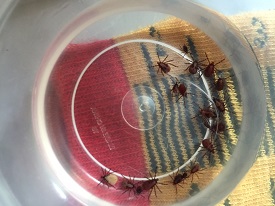
Ticks measured against eighth inch markings.
Lyme disease is transmitted by the deer tick, a tiny eight legged animal that is increasingly common. Ticks live in tall grass and brushy areas, and our yard at Winding Pathways has both. We walk through other places where a tick could have found Rich. Ticks usually crawl around on a person for several hours before digging through the skin and feeding on blood. A wandering tick that has not penetrated the skin cannot transmit disease. Pluck it off and flush it down the toilet or drop it into soapy water.
It’s easy to be scared by negative publicity about Lyme Disease and stay inside. While the disease is serious and is not to be taken lightly, advice to avoid brushy and grassy places must be put into context. These places are beautiful and are homes to interesting wildlife and plants. They are places to get exercise. Even after contracting Lyme we spend part of our time in tick habitat, but we are cautious.
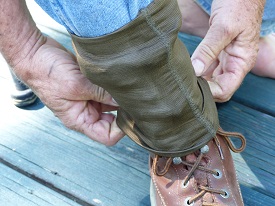
Gaiters fit snugly over boots and pants to deter ticks.
Here’s what we now do:
- Spray our clothes, ankles, and wrists with insect repellent containing DEET.
- When outside for a while we don special tick resistant gaiters (sometimes called spats) that make it hard for a tick to get under pants legs. We bought them from Forestry Suppliers for $13.
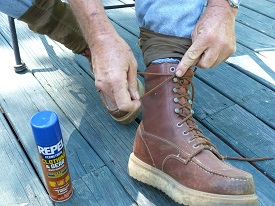
Permethrin-based spray can be bought at most stores that sell insect repellent.
We spray the gaiters with special repellent containing Permethrin that both repels and kills ticks Apply this to clothing, not skin. It is effective for at least two weeks so we don’t launder the gaiters but reapply the spray a couple of times a month.
- Change and launder clothes and shower when we’re done outside. Tiny deer ticks are tough to spot, but we do a body tick check as part of showering.
- Pay attention to our bodies. If we spot a dug-in tick or bulls-eye rash or experience lethargy or joint pain we’ll get to our doctor right away. No procrastination.
Rich emerged from Lyme Disease cautious and smarter but not afraid of being outside in beautiful and interesting places.
FOR MORE INFORMATION
The Internet has great information on ticks and Lyme Disease.
Two of our favorite information sites are:
Centers for Disease Control and Prevention.
WebMD type in the search bar Lyme Disease.
We ordered our tick and chigger gaiters from Forestry Suppliers.
Permethrin based spray can usually be purchased in stores that sell insect repellent. Be sure to read the label.
by Winding Pathways | Apr 3, 2016 | Mammals, Nature, Pests
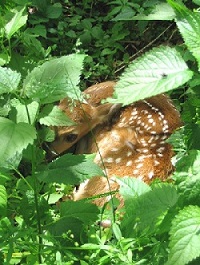
Deer drop fawns in our front yard labyrinth.
Few gardening experiences are as frustrating as discovering a patch of almost ready-to-bloom tulips or ready-to-pick green beans devoured by deer.
Over the past couple of decades deer populations have skyrocketed across North America, making gardening challenging. We have plenty of deer at Winding Pathways and have tried or researched many ways to either eliminate or greatly reduce damage. Here they are:
PLANT CROPS, FLOWERS AND SHRUBS DEER DON’T LIKE: This only sort of works. There are a few plants deer don’t like to eat. Books, blogs, and magazine articles contain lists of plants deer don’t like, but beware. As deer herds increase they get every hungrier, eliminate their favorite foods, and then chow down on plants they don’t particularly like. Also, deer seem to have regional preferences. Connecticut deer may avoid a certain plant that Iowa counterparts love. Winding Pathways Advice: Assume that sooner or later deer will eat just about any plant with only a few exceptions.
KENNEL A BIG DOG IN THE GARDEN: We haven’t tried this one but we’re guessing that the deer will soon figure out that the dog is tied or fenced in and they’ll eat plants just out of Fido’s reach. Winding Pathways Advice: Fido might help but don’t count on him.
SPRAY DEER REPELLENTS ON DESIRABLE PLANTS: It works much of the time. Many commercial repellents are on the market. We’ve made ours from egg yolks blended in water, strained through a nylon stocking to remove most of the thicker egg material and sprayed on plants. At best it is a temporary solution. Really hungry deer will eat the plants anyway, and rain washes most repellents off. Read labels. Some commercial repellents may not be safe on vegetables. Winding Pathways Advice: Repellents help but need to be reapplied after each rain and the deer will find the one plant you overlooked!
BUILD A FENCE: Tall mesh fences work. Electric fences work. Electrified mesh fences work the best. If you want a surefire way to keep deer out build a sturdy fence all the way around the garden. Unfortunately, there are some disadvantages of fencing as follows:
- Electric and tall nonelectric fences are often prohibited by town ordinances
- Fences are expensive but last a long time.
- Fences can be unsightly
- Fences are barriers to both deer and people. Building a fence means passing through a gate every garden visit.
Fences work. If nonelectrified they should be at least seven feet tall. Eight is better. Electric fences don’t need to be as tall and can be several strands of wire or (better) an electrified mesh.
Winding Pathways Advice: This is the one surefire way of keeping deer away from valuable plants. Just remember to close the gate!
WHAT WE’VE DONE AT WINDING PATHWAYS
We take a comprehensive approach to reducing deer damage to our labyrinth, vegetable garden and favorite landscape plants. Here is what we have done and are contemplating.
- Built a 7-foot tall nonelectric fence around our smallish vegetable garden.
- Built sturdy nonelectric fences around young trees.
- Use repellents frequently on special non edible plants.
- Buy a deer tag and harvest one deer per year. It’s legal where we live and we enjoy this
“local free ranging, organic” meat.
We’re considering buying and setting up an electric mesh fence around our labyrinth.
Farm and garden stores sell a wide diversity of nonelectric fencing. Our favorite resource for fences is Premier1. Their FENCES THAT WORK catalog is an outstanding resource. Check out Premier1 in Washington, IA.
by Winding Pathways | Jan 8, 2016 | Nature, Pests
Most people love watching wildlife in their yards, and millions set out bird feeders and improve habitat to encourage colorful and fascinating animals. But there’s a limit.
See a mouse scurry across the floor or find their droppings on the kitchen counter and most families quickly set snap traps to kill the pests. Although there are ways to reduce or prevent most wildlife problems that usually should be tried first, sometimes it’s necessary to kill an animal.
Take woodchucks, for example. These large mammals are capable climbers and powerful diggers. They tunnel under any fence they can’t climb over. A woodchuck’s sweet tooth is the family garden and they readily clear cut carrots, peas, beans, corn, chard and most other crops.
A few July’s ago our garden looked superb. We were harvesting crops like beans, squash, beets and chard. One afternoon we went out to pick a few dinner vegetables and were astonished to find the beans nearly eaten to the ground, the chard gone and the beet tops nibbled to nubbins. It wasn’t the raid of a woodchuck. A whole family of chucks had chosen to squeeze under the fence and convert our garden into their lunch.
We do what we can to prevent or reduce damage. The garden has a sturdy fence around it that keeps deer and rabbits out, but with their superior climbing and digging ability we found that keeping chucks out is nearly impossible.
Our garden is a vital part of our family’s food supply so raiding woodchucks gets the same treatment as a mouse in the kitchen. Fortunately, our home is situated where it is legal and safe to shoot an occasional garden raider. Millions of homeowners live on acreages where they can legally dispatch pests. But it must be done safely. Having a low power firearm or airgun handy can be a garden savior.
We use both a .22 caliber rifle and a .22 caliber airgun both to dispatch an occasional pest and for target practice. Again, shooting a pest is a last resort that we use only when prevention fails, but normally we have to do in a few woodchucks every year.
HOW FIREARMS AND AIRGUNS WORK
Airguns and firearms have similarities and differences. Each relies on air pressure to push a projectile (bullet or pellet) out the barrel and onward to its target. Each can be a safe, effective, and humane tool for dispatching pests but must be used with great care and moderate skill.
When someone pulls a firearm’s trigger a pin strikes the primer of a loaded shell. The impact causes the primer to create a spark that ignites gunpowder. Rapidly burning powder creates tremendous air pressure that pushes the bullet out the barrel.
Pull the trigger on an airgun and high pressure air, already inside, pushes the projectile forward without an explosion of gunpowder. The pressure is generated before shooting by either pumping the barrel or a lever or by inserting a cartridge of pressurized carbon dioxide.
DEVELOPING SHOOTING SKILL
Appropriate airguns and .22 rifles are capable of quickly and humanely dispatching small pests but each can cause severe injury or even death of a person. They must be used with skill and care. Winding Pathways owners Rich and Marion Patterson have extensive experience with firearms. She grew up in rural New Hampshire in a family that hunted for food and also occasionally needed to dispatch a pest raiding their huge garden. He learned shooting during a stint in the army. Many homeowners lack shooting skills and safety knowledge. A good way to gain both is to enroll in a hunter safety course offered in most areas. To locate a class check Where to Hunt. Instructors help novices learn safety and accurate shooting. Many shooting ranges also offer training and are excellent and safe places to practice, sometimes with a coach to help out. To locate a range near your home access Where To Shoot.
Accurate shooting is essential for humane and safe pest control. A precise shot to the vitals will instantly kill a woodchuck while a poor shot will only wound the animal and cause suffering. Develop skill and practice!
.22 RIFLES
At Winding Pathways we often spot our garden-raiding woodchuck close to our home and use our .22 rimfire rifle to dispatch it. Ours is a bolt action that functions with a diversity of ammunition types. The most powerful are called “long rifle” shells. We avoid them because they are overly powerful and noisy. Instead we use either “shorts” or, more frequently, “CB” shells. CB shells have only a small amount of powder and make little noise. They have plenty of power to dispatch a woodchuck hit in the head at 25 feet. Shorts have more power than CB’s but less than long rifles. They extend the effective range but are noisier.
AIRGUNS
Airguns, sometimes called BB guns, vary greatly in quality and power. Old fashioned BB guns fired a round piece of steel called a “BB”. Generally they lack both power and accuracy for serious pest control, but modern airguns are a different matter. Many are of .177 caliber but some are of .22 caliber, which fire a larger heavier pellet that is more lethal than the smaller one. A common system of charging an airgun is to compress air by cocking the barrel. Some airguns will dispatch a pest as humanely as a firearm, but be careful.
Please note: There are pellet guns and there are pellet guns. Some are powerful enough to humanely dispatch a woodchuck and other pests while others lack sufficient power. Our Benjamin .22 titan shoots a 14.3 grain pellet at 750 feet per second, packing enough energy to kill a woodchuck at 25 yards if hit in a lethal area. Another of our pellet guns is much lower powered and is used strictly for target practice.
CAUTION
Before using an airgun or rifle on your property:
- Make sure it’s legal and safe.
- Become familiar with the airgun or firearm. Read the owner’s manual.
- Always practice safety and treat your airgun or .22 as if it’s loaded.
- Develop skill. Never shoot at a pest until you have mastered accuracy and can kill it humanely. Practice often.
- Store it safely. We keep ours in a large locked box, where it stays until used. Store ammunition away from the weapon. Always keep a weapon away from children.
FOR FUN
We enjoy target shooting and have made a simple range in our backyard. Every once in a while we take the airgun out and enjoy punching holes in paper targets.
FOR INFORMATION
For general information on shooting, safety and where to find a place to shoot go to the National Shooting Sports Foundation.
by Winding Pathways | Dec 30, 2015 | Birds, Mammals, Nature, Pests
Watching backyard wildlife yields amazing sights and education. We recently noticed two things at Winding Pathways that reminded us about how many animals are downright smart.
Both involved a manufactured trap that supposedly catches House Sparrows. We have more of this pesky bird than we’d like so we set the trap under a feeder and baited it with cracked corn. A few minutes later an intrepid chipmunk entered the trap’s funnel-like door, feasted on seeds, and couldn’t find his way out. We gently released him and set the trap back on the corn.
A few minutes later we were amazed to see the chipmunk back and watch it tunnel under the trap to reach the bait! He’d learned that entering the trap brought trouble and figured out how to safely reach lunch.
Our sparrows are even smarter than the chipmunk. Not a single one entered the trap. Instead they feasted on corn and millet on the ground around the feeder. After a few hours they had eaten all the safe seed but they still wouldn’t enter the trap.
We now have new respect for the intelligence of both chipmunks and House Sparrows.
-
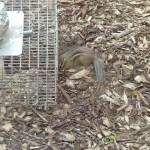
-
The chipmunk figured out how to tunnel under the live trap to reach the corn.
-
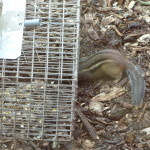
-
Having excavated, the chipmunk now enters the tunnel to get the corn.
-
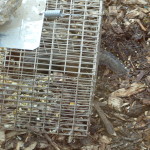
-
In and Under!
-
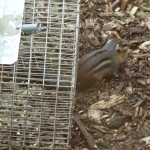
-
With pouches full, the chipmunk emerges.
-
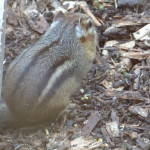
-
The chipmunk figured how to tunnel under the live trap, gather up the corn and emerged with pouches full.
by Winding Pathways | Nov 30, 2015 | Mammals, Nature, Pests
We love watching frolicking squirrels in our yard and every year we buy bags of corn for them to snack on. We draw the line when they climb up to feeders and gobble expensive seeds meant for chickadees, nuthatches, and woodpeckers.
Bird feeder companies all tout their “squirrel proof” feeders and a homeowner can spend a bundle on different feeders just to slow the flow of seed from feeder to squirrels’ mouths. Some preventions work better than others but a reliable company is Droll Yankee.
But, being partly of Yankee stock, we took the economical route. To thwart the hungry mammals we mounted our feeders on steel pipes and even ringed some with metal stove pipe. Somehow they managed to dig claws into the metal, climb and feast on expensive seed.
Then we discovered spray grease. It’s sold in hardware stores and is meant to spray on drawer slides, hinges, and other balky metal parts. We sprayed it on the metal pipes holding up the feeders. Squirrels gingerly put their feet on the pipe and backed off as soon as they felt the grease. It works.
Spray grease only lasts a few weeks and needs to be reapplied, but it is a simple way to discourage squirrels from climbing to feeders.
-
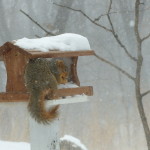
-
Even in the teeth of a storm, squirrels feast to tide them over.
-
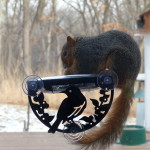
-
Boldly the fox squirrel hunkered down at the window feeder.
-
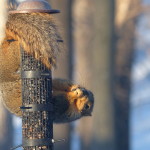
-
Quite the acrobat, this squirrel hung for more than 30 minutes eating seed.
-
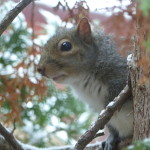
-
A cautious squirrel scoping out the action.
-
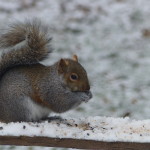
-
A hungry squirrel
-
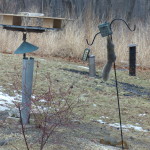
-
Squirrels have an amazing ability to climb just about any vertical pole.
-
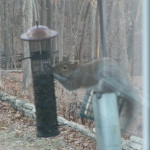
-
This squirrel learned to climb the metal deflector pole and reached into the hanging feeder.
-
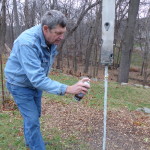
-
This grease works for a while. Remember to re-apply.
by Winding Pathways | Nov 2, 2015 | Mammals, Nature, Pests
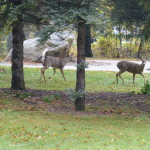
On Halloween day a buck was hot on the “tail” of this doe and yearling.
Drivers, be cautious! Across most of North America early November is the most likely time for a car to collide with a deer. Too often it happens even in suburban neighborhoods and a collision usually does extensive damage to a car, injures or kills the deer, and sometimes even people are killed or hurt.
At our home at Winding Pathways we watched a buck chase a doe on Halloween afternoon. That’s slightly early, but during the next two weeks more cars will hit deer than in any other time period in the year.
In early November female deer come into estrus in northern states with peak activity a week or two later in the south. Big antlered bucks have the uncanny ability to stay out of sight most of the year, but in November they abandon caution and run through backyards and cross roads at any time of day or night. A doe in heat is usually followed closely by an eager buck.
Within weeks nearly all does will be pregnant and the rut fades, but usually it’s followed by a somewhat less intense breeding time in about a month when any nonpregnant does mate. By Christmas nearly all does are pregnant and will give birth late next spring.
When driving through deer territory always be careful, but in early November be especially cautious. Go easy on the gas pedal, keep your eyes open and if one deer crosses the road in front of you expect others to follow. Look in the direction the deer came from. Others likely will be about to cross.
An interesting overview on deer rutting can be found at The Noble Foundation.



















